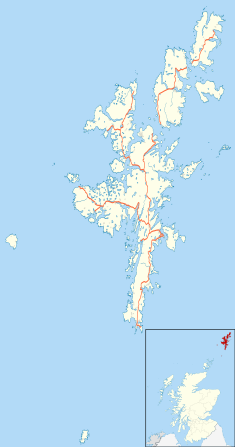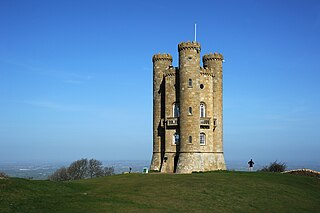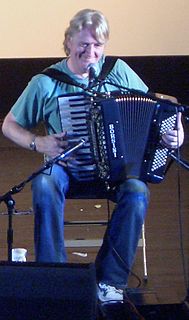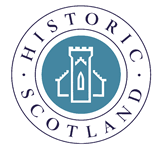
Stourhead is a 1,072-hectare (2,650-acre) estate at the source of the River Stour in the southwest of the English county of Wiltshire, extending into Somerset. The estate is about 2 1⁄2 miles (4 km) northwest of the town of Mere and includes a Palladian mansion, the village of Stourton, gardens, farmland, and woodland. Stourhead has been part-owned by the National Trust since 1946.
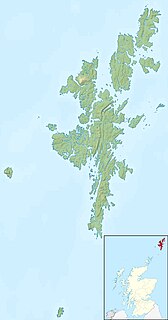
Yell is one of the North Isles of Shetland, Scotland. In the 2011 census it had a usually resident population of 966. It is the second largest island in Shetland after the Mainland with an area of 82 square miles (212 km2), and is the third most populous in the archipelago, after the Mainland and Whalsay.

Petworth House in the parish of Petworth, West Sussex, England, is a late 17th-century Grade I listed country house, rebuilt in 1688 by Charles Seymour, 6th Duke of Somerset, and altered in the 1870s to the design of the architect Anthony Salvin. It contains intricate wood-carvings by Grinling Gibbons (d.1721). It is the manor house of the manor of Petworth. For centuries it was the southern home for the Percy family, Earls of Northumberland. Petworth is famous for its extensive art collection made by George Wyndham, 3rd Earl of Egremont (1751-1837), containing many works by his friend J. M. W. Turner. It also has an expansive deer park, landscaped by Capability Brown, which contains the largest herd of fallow deer in England.

Fawsley is a hamlet and civil parish in the Daventry district of the county of Northamptonshire, England. The population at the 2001 census was 32. At the 2011 census the population remained less than 100 and is included in the civil parish of Charwelton.

Hawkstone Park with its follies is an historic landscape park with pleasure grounds and gardens formerly belonging to Hawkstone Hall, near to Market Drayton, in Shropshire, England, one mile (1.6 km) east of the A49 road.

Clevedon Court is a manor house on Court Hill in Clevedon, North Somerset, England, dating from the early 14th century. It is now owned by the National Trust. It is designated as a Grade I listed building.
Arthur Nicolson may refer to:
There have been six baronetcies created for persons with the surname of Lawson, two in the Baronetage of England and four in the Baronetage of the United Kingdom. Two creations are extant as of 2010.
Richard Farrer Herschell, 2nd Baron Herschell, was a British Liberal politician.
The Nicolson baronets refer to one of four baronetcies created for persons with the surname Nicolson, all in the Baronetage of Nova Scotia. Two of the creations remain extant as of 2008.

Funzie Girt is an ancient dividing wall that was erected from north to south across the island of Fetlar in Shetland, Scotland. Some sources describe it as having been built in the Neolithic, but the date of construction is not certainly known. The line of the wall, which ran for over 4 kilometres (2.5 mi), once divided the island in two almost equal sections. Also known as the Finnigirt Dyke, it has vanished in places at the southern end, although the ruins are clearly visible along much of the uninhabited north of the island, where it is a conspicuous feature of the landscape. The dyke's original purpose is not known, nor is its relationship to other archaeological sites of a similar age nearby. There are various folk tales about its construction, and it is the subject of various pieces of Shetland folk music.

Gardie House is an 18th-century estate house on Bressay in Shetland, Scotland. Located opposite Lerwick, across the Bressay Sound, Gardie is described by Historic Scotland as an "example of the smaller Scottish country house, unique in Shetland."

Ardgowan House is a late 18th-century mansion and estate on the Firth of Clyde near Inverkip, Scotland. Ardgowan is located in Inverclyde, in the former county of Renfrewshire. The Ardgowan estate has been held by the Stewart family since the early 15th century: towards the end of that century, their tower house Ardgowan Castle was built within the site of the previous Inverkip Castle fortress. The present house was erected in 1797 and completed in 1801 from designs by Cairncross. It is the seat of the Shaw Stewart baronets, currently Sir Ludovic Houston Shaw Stewart, 12th Baronet of Greenock and Blackhall.

Blackadder House was an estate and stately house near the village of Allanton, in Berwickshire, Scotland. It was built on the site of the earlier Blackadder Castle. The house was vandalised by troops in World War I. Since there was no money to repair it, the house was demolished around 1925.
The Society of Our Lady of the Isles (SOLI) is a small Anglican religious order for women, founded in the late 20th century. It is located in Shetland, and is part of the Scottish Episcopal Church. It is arguably the most remote community within the Anglican Communion. The Rule of the community is a mixture of Franciscan and Cistercian, but with heavy Celtic influences.

Penicuik House survives as the shell of a formerly grand estate house in Penicuik, Midlothian, Scotland. The 18th-century palladian mansion was built on the site of an earlier house by Sir James Clerk, 3rd Baronet. It was destroyed by fire in 1899 and a major restoration was completed in 2014 by G Brown Stonemasons.
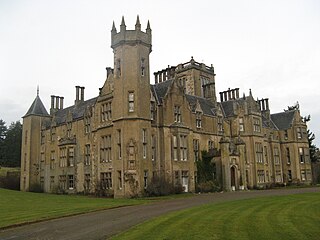
Forglen House is a mansion house that forms the centrepiece of the Forglen estate in the parish of Forglen, northwest of Turriff, Aberdeenshire, in the northeast of Scotland. The lands were given to the abbots of the Abbey of Arbroath by King William the Lion before 1211 and the Monymusk Reliquary was held there. The original castle, built around 1346, was replaced by a vernacular harled house that was later extended. Significant development of the estate began when it was acquired by the family of Lord Banff and they started the work of landscaping and planting trees. It became their main family seat during the 18th century. After the death of William Ogilvy, the eighth and final Lord Banff, the estate passed by marriage to the Abercromby baronets who continued to enhance the property and maintained it as their main residence. Sir Robert Abercromby, 5th Baronet commissioned the Aberdeen City Architect, John Smith to design the present house in 1839.
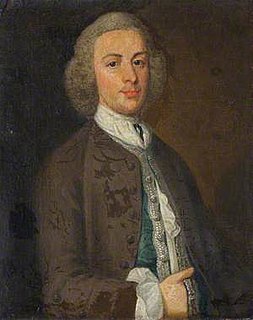
Sir Jacob Gorman Downing, 4th Baronet was an English baronet and politician. He was the grandson of Sir George Downing, 1st Baronet, namesake of Downing Street; and cousin and heir of Sir George Downing, 3rd Baronet, whose Gamlingay estate would eventually establish Downing College, Cambridge despite illegal attempts by Jacob and his widow to prevent the university from receiving the estate.

Newhailes House is a Palladian style country house which stands in 80 acres of parkland on the edge of the small town of Musselburgh in East Lothian, Scotland. Originally named Whitehills, it is a Category A listed building which is now occupied and maintained by the National Trust for Scotland.




